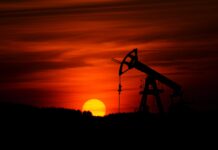
Views expressed by contributors do not necessarily reflect the editorial views of SHALE Magazine.
The oil and gas industry is complicated and confusing to many people. For example, if you told a person on the street that in a typical shale well 20 million gallons of water are used in up to 40 separate fracking operations along a 1-2 mile horizontal well, their eyes may look blank. But if you explain that all that water, if poured into a football stadium, would rise to a height of 40 feet over the grassed area, that may surprise them.
Now, if that well, and many others, were drilled in a drought-stricken state, such as New Mexico, some rancher might say that’s too much freshwater, and it’s stealing from the aquifer. But a wider perspective would reveal that the total amount of water used in drilling wells and fracking them is less than 1% of the state water budget, and a drilling foreman might say it’s a negligible amount of water.
The oil and gas world is filled with such contradictory and confusing points of view. Further, the natural human response is to pick one side and defend the position, often without properly listening to the other side. These are reasons I wrote the book called “The Shale Controversy”: so parents can tell their children both sides, so ranchers can talk to oilmen with more understanding and respect, and so environmental enthusiasts can discuss with industrialists and seek a middle ground.
Other conflicts from the fracking arena.
The book considers other examples. Does fracking contaminate aquifers? Not in shale wells. But occasionally, an aquifer does get contaminated, and it’s due to a poor cement seal between the well casing and the raw rock. Or it’s due to surface spills of liquid used in well operations.
Earthquakes in Oklahoma were another issue, and a hot one in the period 2010-2017. Swarms of earthquakes that reached a high of 900 in 2015 were induced by oilfield operations. It was easy for people to blame fracking. But finally, the cause was traced to disposal wells where injected wastewater triggered faults deep in the basement. The Shale book documents this history in an easy-to-read manner.

Success of the shale revolution.
“The Shale Controversy” documents the success of the shale revolution. The obvious factors are cheap oil and gas for cars, homes, and businesses. It is accessible plastics for offices, kitchens and cars. A big one is the United States became self-sufficient in oil for the first time since 1947. That’s a goal that every other country of the world would like to achieve because the costs of importing oil can seriously affect in-country budgets.
Finally, the growth of manufacturing industries and jobs directly and indirectly related to oil and gas have lifted millions of people around the world into the middle class.
Global warming – the biggest controversy.
First, we lay some groundwork. Fossil energy is responsible for 75% of global greenhouse gases (GHG). Second, temperature is rising faster than at any time in the last 10,000 years. Third, atmospheric concentration of CO2, the main global warming gas, is higher than in the past 3 million years.
Fourth, if GHG are not controlled, then by the year 2100, the global temperature is predicted to be higher than in the past almost million years. Does the world want to risk entering a twilight zone?
A visit to Australia.
2019 was one of the three hottest years on record, the others being 2016 and 2020. In August of 2019, I spent a week four-wheeling through the outback of South Australia. A drought was on, and we didn’t see a blade of green grass even though it was mid-winter. We did see a lot of dead kangaroos.
That drought extended into southeastern Australia, and it blew up in October 2019. Unprecedented wildfires consumed the forests all the way to the ocean, where people were standing in the sea to avoid the flames and heat. It was hard to find any climate deniers in those parts. The wildfires killed over a billion animals, including koala bears, and lasted through January 2020.
At the same time, shocking wildfires were out of control along the west coast of the USA. California’s fire season finished with a bang — six of the larger fires started in October 2019. The largest was the Kincaide fire that burned 77,000 acres. In 2019 there were 6,900 fire incidents in California alone, with 732 structures burned.
Can a single event, or two extreme events, confirm global warming? An honest answer is no. The proper way to tell is to plot the intensity or frequency of extreme events such as wildfires or hurricanes over the last 50 or 100 years and look for a trend. While such plots of glaciers retreating and Arctic ice melting do reveal a worsening trend, the plots of wildfires or hurricanes in North America do not (Ref 1). Once again — two different sides of the “evidence” story.
How to talk to your grand-children.
A woman asked, how does a person talk with grandchildren about climate issues? She said she couldn’t accept emotional statements touted by some environmental extremists — such as, “Fracking needs to be banned right now because of the aquifer contamination it’s causing.”
My reply was, that was why I wrote “The Shale Controversy.” It’s for intelligent people who want to understand the issues and want to know both sides so they can make up their mind, and so they can communicate respectfully with others — including their children or grandchildren, neighbors or coworkers.
I also reminded the woman that emotional statements have been made by extremists on the other side who say, “Global warming and climate change are a hoax.”

Where does all this leave oil and gas companies of New Mexico?
Oil and gas companies in New Mexico are in the eye of the storm. Partly because the Delaware Basin is the premier oil and gas basin in the USA, producing about 1 million barrels of oil per day (BPD). And partly because about half of the oil and gas produced is from wells on federal land, where recently new drilling leases have been banned for 60 days and possibly a year.
Even though companies have stockpiled well leases that will last four years, the ban will gradually lower production of oil and gas in New Mexico.
Momentum is changing fast, and the writing is on the wall — demand will gradually slow for products of the oil and gas industry. This has been called a “glide-path,” using the words of Senator Heinrich of New Mexico. But it would be good for the New Mexico airplane to see clearly the runway in the desert that is built on six ground truths:
1. Burning fossil fuels cause 75% of greenhouse gas emissions.
2. Oil and gas will still be significant by 2050 — perhaps 30-50% of energy consumption.
3. The most practical timescale for the transition from fossil energy to renewables is a goal of net-zero greenhouse gas emissions by 2050. Not actual zero, but net zero.
4. During the transition, workers need to be retrained or their jobs otherwise preserved.
5. One-third of New Mexico’s state revenue, currently provided by oil and gas, needs to be sustained in some way.
6. A “social contract” implies oil and gas companies will demonstrate genuine concerns for the environment.
Steering a glide-path.
Here are five suggestions to ensure the plane reaches its desired target:
• Switch to green power to provide all oil and gas operations. For example, drilling or frac pumping.
• Reduce to near-zero flaring of gas and leaking of methane from wells, pipelines, and facilities. • Develop and implement carbon capture and storage in old oil and gas fields. This will be part of the social contract, and contribute to the net-zero goal, and will preserve jobs. Occidental is leading this effort, even capturing CO2 from the air and injecting it underground.
• Redirect some investments from new oil and gas drilling to renewable energies. BP will be invested 40% in renewables by 2030; Total is investing $2.5 billion in Adani Green Energy, a company out of India, and will own 50% of their solar electricity.
• Make an opportunity out of the leasing ban to redirect investment into renewables – perhaps on the very same federal lands, which are ideal country for wind farms or solar collector systems. References: Gregory Wrightstone, Inconvenient Facts, Silver Crown Productions, 2017.
About the author: Ian Dexter Palmer lives near the mountains in Albuquerque, New Mexico. He has a Ph.D. in physics from Adelaide University, Australia. By profession, he is a petroleum engineer who consults all over the world. His books include “The Shale Controversy,” “Fracman Conflicted,” “Hiking toward Heaven,” and
“Weed and Water.”














